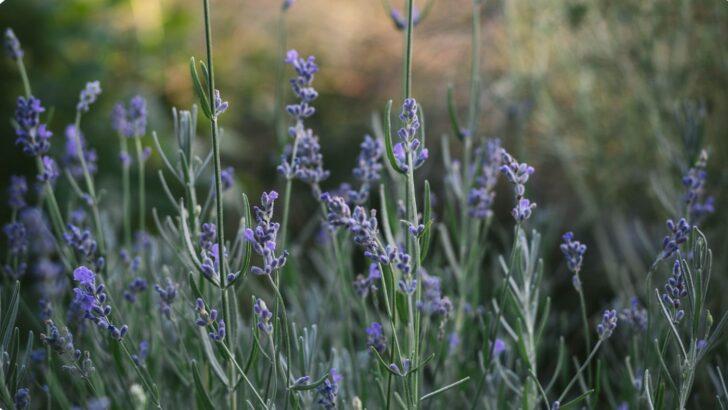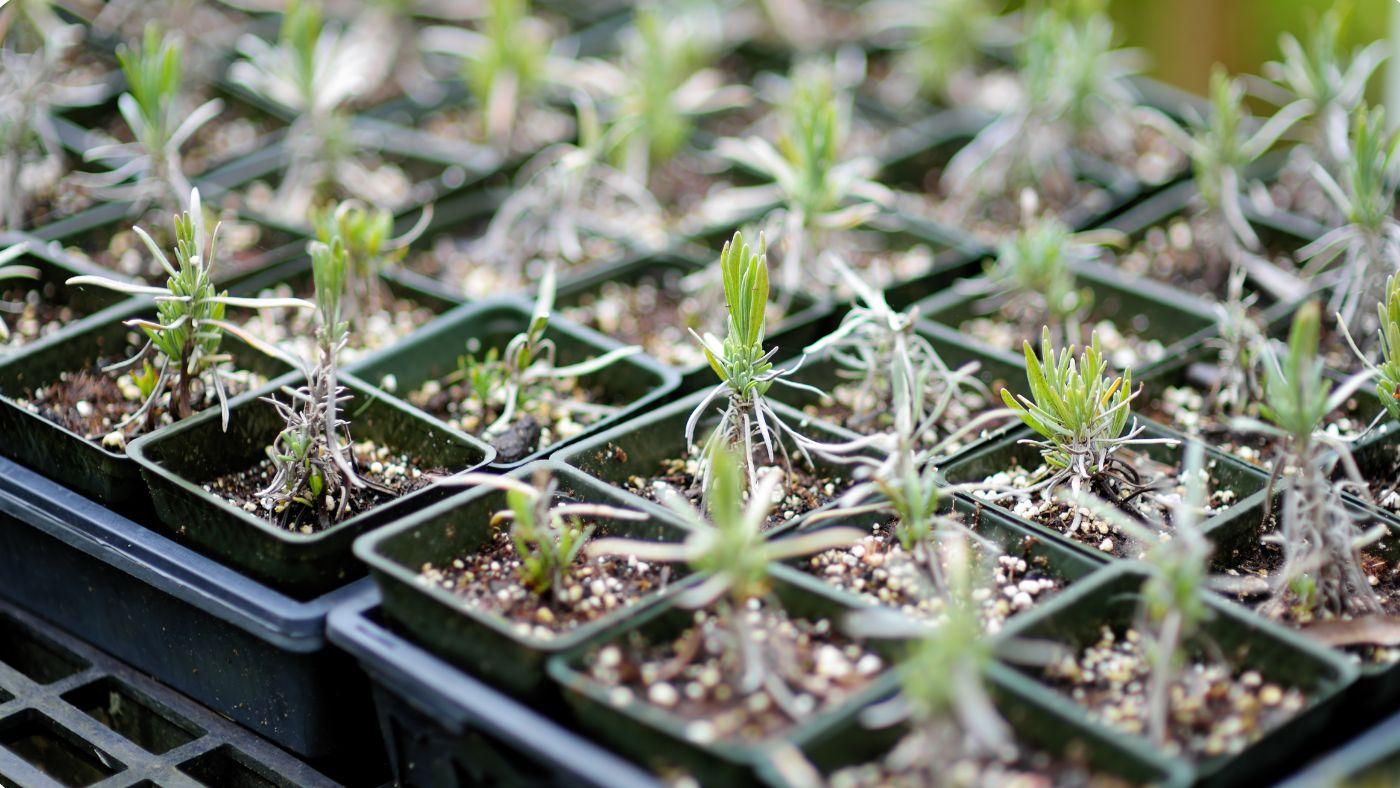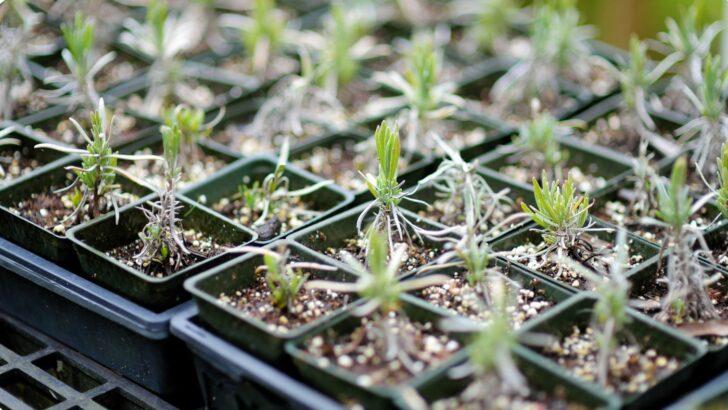Lavender is by far one of my favorite herbs to grow in the garden. Said to bring good luck, it is also beautiful, prolific, has multiple uses, and smells extraordinary. Growing lavender from seed, while requiring some patience, is a fantastic way to add this amazing herb to your backyard garden.

Much like lavender coming to life in the spring after a winter of dormancy, lavender seeds can take quite a while to germinate. The plants also may not flower in their first year, especially if you start your seeds in the fall. But, growing lavender from seed, while it does take time, can open up the opportunity to grow varieties you may not find at your local nursery.
You are viewing: What Do Lavender Seedlings Look Like
When to Start Lavender Seeds
Lavender seeds can be started any time the soil is workable, depending on your zone and what you’re trying to accomplish. For starting indoors, typically you’ll want to start them between early February and late August.
You’ll need approximately 10-12 weeks to grow lavender and get it ready to transplant outdoors. If you’re planting in the spring, count back 10 weeks from your last expected frost date to give you a good window of time to start the seeds.
If you want to plant lavender in the fall, which is not at all impossible, even in cooler climates, you’ll want to count back 10 weeks before your expected first frost date to determine the latest you can start your seeds.
How to Germinate Lavender Seeds

Lavender seeds require cold stratification for the highest and most successful germination rates. While you can create a moist environment and truly cold stratify the seeds, I’ve found dry seed stratification, just throwing a packet of seeds in the refrigerator, often works well enough.
Once you’ve put the seeds through a period of cold treatment, you can plant them. Lavender requires light to germinate, meaning you don’t want to plant the tiny seeds deeply, or they’ll never break the soil surface.
Instead, it’s best to simply scatter the seeds on top of the seed starting medium of choice and lightly sprinkle them with more to get the best germination rates. They can be started indoors, for the highest success, or even outdoors if you choose.
Starting Lavender Seeds Indoors
Lavender seeds germinate more quickly in controlled environments with adequate exposure to sunlight. So, while you can simply spread seeds on top of your warm garden soil, they’ll do better if you start the seeds indoors.
You’ll want to sprinkle the seeds on top of your moist soil block or seed starting mix, and lightly, if at all, cover them with a dusting of vermiculite, or finely sieved compost. This ensures they receive enough sunlight to sprout up. If they’re buried underneath a layer of soil, they will not germinate well, if at all.
Lavender, being of Mediterranean origin, loves heat, sun, good airflow, and dry soil. This means utilizing a heat mat, a grow light, and simply spritzing the top layer of soil with water when it begins to dry out, which will provide the perfect conditions for high germination rates.
Lavender grows best at a temperature of 65°F to 75°F, so if you do not have a warm spot to plant them, utilizing a heat mat can be beneficial. This is especially true if you’re starting your seedlings in a greenhouse or another cooler, unheated area.
Read more : What Does Csi Stand For In Construction
Once the seeds are planted, place a humidity dome on top of the seedling tray, put a heat mat underneath, and be sure the seeds have access to adequate sunlight through a south-facing window or, better yet, from a grow light.
The seeds can take anywhere from two weeks to a month or sometimes more to germinate, so be patient. Be sure you’re keeping the soil moist, but not saturated, to avoid fungal issues. Once you see seedlings beginning to sprout, remove the humidity dome to allow for adequate airflow.
Starting Lavender Seeds Outdoors

While this method can definitely be hit or miss, you can successfully start lavender seeds outside. While most folks think of starting seeds in the spring, lavender seeds can even be started in the fall or the end of winter before spring has really warmed the soil.
To start seeds outdoors, you’ll simply spread them around on top of well-draining, well-worked soil. You can lightly dust the top of them with fresh soil if you’d like, but it’s not necessary.
Starting seeds in the late winter/early spring means you can start them without cold stratification being performed first as this will give them that cold, dormancy period they need to germinate. The seeds can be started outdoors as soon as the soil is workable and could even be winter sown successfully.
Keep in mind, if you start them later in the spring or in the autumn, you’ll need to cold stratify them first. Since lavender can take anywhere from a couple of weeks to over a month to germinate, you need to be sure you’re allowing adequate time for the seeds to germinate and the plant to establish itself before cold weather hits, so count backward 8-10 weeks, at a minimum, to decide when to start the seeds for a fall planting.
Caring for Lavender Seedlings
The biggest challenge with lavender seedlings is they can turn into leggy seedlings very quickly. To prevent this, you need to be sure they’re receiving adequate light. While some people are successful with utilizing a sunny window, it’s really best to use a grow light.
Keep the grow light 1-2″ above the seedlings, moving it up as they grow until they’re ready to transplant.
Lavender is highly susceptible to fungal disease, and while it needs adequate moisture, too much is a bad thing. Keep the soil lightly moist by spritzing it when it begins to dry out, never soggy, or the lavender will likely succumb to disease.
Lavender is not a heavy feeder and not particularly needy so while you can use a bit of fish emulsion to fertilize it once it has about 4-5 true leaves, you can fertilize it if you’d like to. However, too much of a good thing will also kill the plant, so be mindful with how much you fertilize, how often.
When to Transplant Lavender Seedlings
Lavender seedlings will sprout with their two cotyledons, like most other seedlings. However, they will quickly transform into baby lavender plants in no time.
Be sure to harden off your lavender seedlings properly before you transplant them into the garden. Like any other seedling, they are vulnerable to extreme changes in climate and need time to properly acclimate to the outdoor world before they’re transplanted outdoors permanently.
Read more : What Percent Of 90 Is 27
For the best results, be sure to wait to transplant the seedlings until all threat of frost is gone, mid-May in our zone 5 garden. It’s also best to wait until the plants are a minimum of 2-3″ before transplanting.
To transplant, space the plants 12-18″ apart in well-draining soil that receives full sun. While they’re not heavy feeders, you can cover the plants with a layer of rich compost to help slowly feed the soil.
Be sure the plants will receive adequate airflow by not overplanting the area surrounding them.
Lavender does not fair well in wet, humid soil conditions. Water only when the top 2″ of soil has dried out.
Will lavender bloom in its first year?

Lavender is particularly slow growth in its first year. That being said, most plants will bloom in the first year.
However, even if they don’t, do not fret. By the second year in the garden, you’ll have enough lavender to harvest, dry, and make lavender tea, lavender salve, soap, and make smudge sticks for Litha along with other amazingly scented concoctions with this incredibly versatile herb.
Can lavender be grown in containers?
Lavender does very well in containers. In fact, in the deep south the humid, moist conditions make lavender grow better in containers than it does in the ground. This is due to the fact that the soil conditions, airflow, and moisture can be better controlled by utilizing containers than placing them directly into the ground.
Like most plants, some cultivars do better in containers than others. Munstead Lavender stays compact and does very well in container gardening situations. Another well-growing container variety is the hidcote variety.
To grow lavender in containers, simply transplant the seedlings you started into a pot that is a minimum of 12″ in diameter.
Fill the pot with well-draining, sandy soil. An herb soil mixture like this one can do well, or simply combine 70% compost with 30% horticultural sand to create a good, gritty soil mix that lavender plants will love.
Lavender is a versatile and amazing plant. While planting it from cuttings or transplants from the nursery is fairly easy, growing it from seed opens up the opportunity to try different varieties and start and plant it when you and your garden are ready.
If you’re looking for ideas on how to reconnect with your food, nature, and the heritage way of life, you’ve come to the right place.
Join over 40,000 like-minded folks in my Facebook group, The Self Sufficient Life. You can join by clicking here.
Source: https://t-tees.com
Category: WHAT
